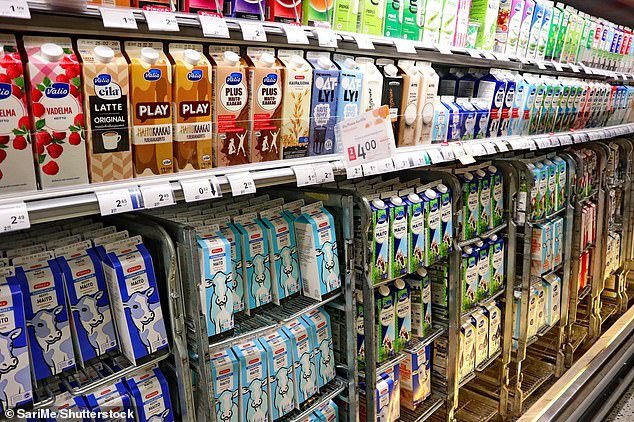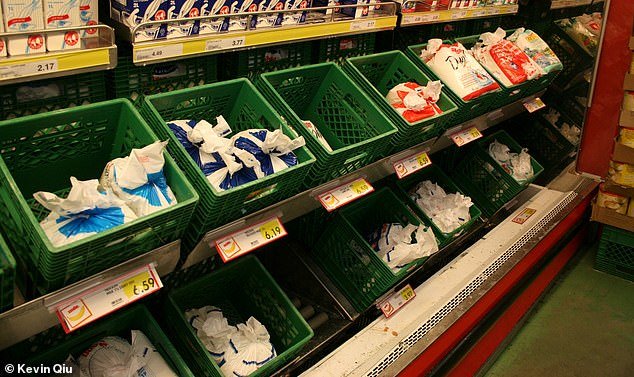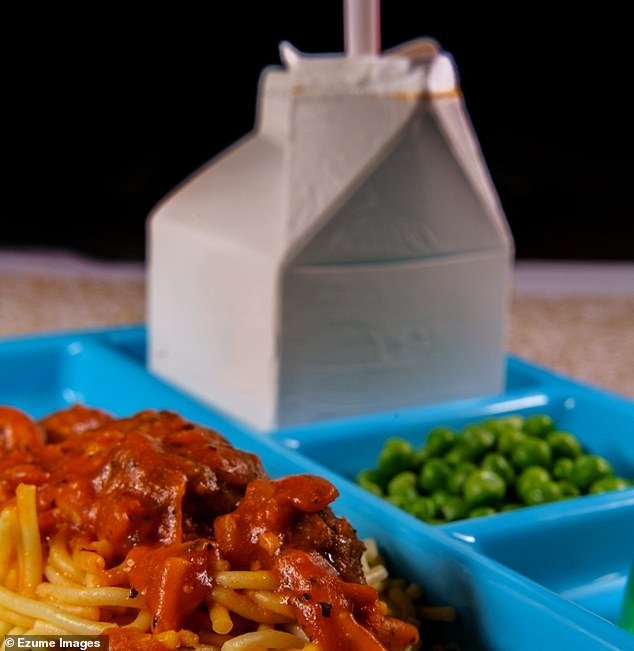Glass bottles preserve milk’s flavour better, scientists say
>
For decades in Britain, milk has been delivered in glass pint bottles in the wee hours by the cheery milkman.
But soaring costs and the pressure to switch to alternative packaging could replace this valued tradition once and for all.
Now, a new study shows milk’s packaging really does influence its flavour – and that glass is best if you want to fully appreciate it.
Scientists found trendy paperboard cartons – which are increasingly being used for milk sold in supermarkets – don’t preserve its freshness or flavour as well as glass.
In experiments in the US, glass and plastic were found to be the best for preserving flavour and freshness of milk (file photo)

Scientists found trendy paperboard cartons – increasingly being used for milk sold in supermarkets – don’t preserve its freshness or flavour as well as glass. Pictured, dairy and non-dairy milk options sold in paperboard cartons
Paperboard cartons are widely used in schools, especially in the US, so the findings suggest a switch to glass could help children enjoy their milk more.
Glass and plastic, meanwhile, were the best for preserving flavour and freshness, according to the study, which follows figures last year illustrating the soaring price of glass bottles delivered to UK homes.
‘Milk is more susceptible to packaging-related off-flavours than many other beverages because of its mild, delicate taste,’ said study author Mary-Anne Drake at North Carolina State University.
‘[We found] milk’s taste can be impacted by the exchange of the packaging’s compounds into the milk and by the packaging absorbing food flavours and aromas from the surrounding refrigeration environment.’
To investigate the flavour impacts of packaging, the researchers examined pasteurised whole and skimmed milk stored in six half pint containers.
Aside from glass, the team used paperboard cartons, three plastic cartons or jugs (made from different plastics) and a plastic bag, known as a milk bag.

Plastic bags containing milk – known as ‘milk bags’ – in a grocery store in Ontario, Canada (file photo)
All milk was stored in total darkness to control for light oxidation – which is also known to affect milk’s flavour – and kept cold at 4°C (39°F).
The samples were tasted and analysed on the first day of the experiments, then again at five, 10, and 15 days after.
A trained panel examined the sensory properties of each sample, while the researchers extracted compounds to see how the packaging was intermingling with the milk.
Finally, the samples underwent a blind consumer taste test on day 10 to see whether tasters could tell any difference between milk stored in the paperboard carton or the plastic jugs compared with the milk in glass.
Of the different packaging types, paperboard cartons and the plastic bag preserved milk flavour and freshness the least, the researchers found.
Milk packaged in paperboard cartons had distinct off-flavours such as ‘refrigerator’ and ‘stale’ as well as lower sweet aromatic flavours, while the presence of compounds from the paperboard was also present.
Overall, off-flavours in milks detected by the tastings were correlated with increased migration of volatile compounds (from the packaging into the liquid).
Interestingly, skimmed milk was found to be more susceptible to flavour impacts than whole milk, found the study, which has been published in the Journal of Dairy Science.

Paperboard cartons (pictured) are widely used in school meal programmes in the US (file photo)
It’s worth noting that the milk in the experiment was stored in the dark, which is crucial to maintaining its flavour if in clear glass.
A problem with a clear glass bottle is it allows light oxidation – the chemical reaction of fat molecules with oxygen, catalysed by light.
Because light oxidation impacts milk’s flavour, dairy companies have been switching to dark glass that blocks the light.
Glass bottles are also said to be worse for the environment than plastic because manufacturing glass uses more energy and resources.
This is why trendy eco-friendly breweries are increasingly making the switch from glass bottles to cans.
